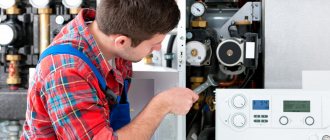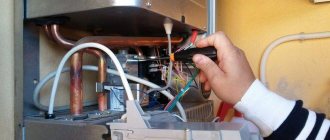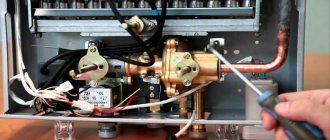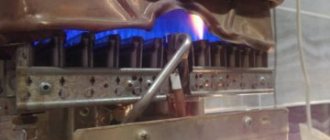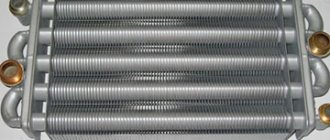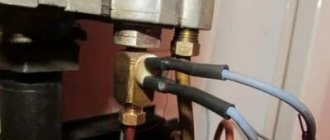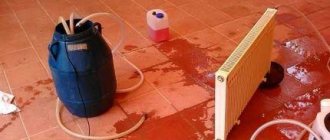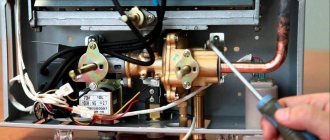Backdraft in the combustion chamber, which occurs during gusts of wind, is a fairly common problem. A gas boiler constantly goes out during strong gusts of wind, which impairs its efficiency; due to frequent clocking, it reduces its service life, and models with manual ignition have to be constantly ignited even in the middle of the night.
The problem can arise both in floor-mounted atmospheric boilers with an open combustion chamber and a vertical chimney, and in boilers with a closed combustion chamber and a coaxial chimney. However, correcting the situation in more than 90% of cases is not difficult.
Pouring technology
Forming a concrete floor on the ground is a rather complex procedure that requires compliance with the following sequence of actions:
First of all, a rough foundation is prepared. To do this, the top layer of soil is removed, and in its place is placed dense soil, which was obtained after digging a hole for the foundation. Try to completely remove soil containing organic matter, as it will rot and sag over time. After leveling, this layer must be compacted with a vibrating plate.
Please note that the bottom of the wire should not come into contact with the insulation. Therefore, the entire mesh is raised above the surface using special plastic bosses
If it is planned to form a warm floor inside the room, then all its elements must be placed directly on the fittings.
When everything is ready, fill the floor from scratch
It is important here to do everything at once in order to form a monolithic structure. Alignment of the screed occurs according to previously installed beacons or relative to marks on the walls
Before pouring, be sure to secure damper tape along all walls. It can be purchased at any hardware store or made from small pieces of polystyrene foam.
Finishing the floor occurs only after the concrete has completely dried. This period can last from 1 to 2 months depending on the thickness of the screed.
How to prevent a gas boiler from blowing out
If the chimney pipe of a gas heating boiler blows out during a strong wind, the problem lies in the boiler itself (more precisely, its automation), or in the incorrect design of the chimney. Attenuation that occurs once every few seasons usually does not require human intervention and is normal.
But, if the situation repeats, it will be necessary to take measures aimed at improving draft in the chimney duct or repairing boiler equipment.
What type of gas boiler to choose so that the flame does not blow out
The minimum speed of flue gases at which the flame will not be blown out is 6-8 m/s. Flows of heated air entering the chimney move in a spiral. The vortices gradually increase in speed, which reaches maximum intensity at the exit from the chimney.
There are boilers in which the natural movement of flue gases is replaced by forced one. The design of turbocharged models with a closed combustion chamber includes two blower fans. The first one supplies air to the firebox, the second one removes combustion products. It is impossible to blow out a turbocharged unit with wind. Attenuation indicates that one of the failed fans needs to be replaced.
How to make a chimney pipe correctly so that the boiler does not blow out
To protect the gas boiler from blowing out when the wind increases through the exhaust pipe, it is necessary to install a chimney in accordance with existing building codes:
- The height of the pipe head is calculated depending on the distance from the roof ridge. It is optimal to install the chimney in the center of the roof, raising it by 0.5 m.
The problem of a gas boiler blowing out without increasing the height of the exhaust pipe can be solved by installing special equipment. Anti-blowing devices include a deflector that prevents backdraft and an economizer, installed near the boiler and increasing the intensity of flue gas movement. A traditional and effective method of improving traction and preventing blowing is a pipe cap.
In addition to the required pipe height, a chimney device with protection against blowing in strong winds must comply with the following standards:
- Horizontal pipe sections are kept to a minimum. The maximum length is no more than 1 m. In total, the length of all horizontal sections should not exceed 3 m.
- Installation of no more than 2 rotary corners is allowed.
- The chimney pipe has a round or oval cross-section. Square pipes significantly reduce traction characteristics.
- It is necessary to properly insulate the chimney.
The design of the smoke channel, which prevents blowing in, must be of the required height and equipped with a canopy or deflector. The cross-section of the smoke channel is exclusively round and not square. There are no installation violations. You can ensure compliance with these requirements yourself.
Additional conditions to prevent blowing include precise automatic settings. Only a competent specialist, a representative of the gas service, can adjust the operation of heating equipment. If the conditions described above are met, the attenuation of the boiler, due to strong gusts of wind, will be reduced to a minimum or disappear altogether.
Thermostat is not installed where it should be
For proper operation of the boiler room, it is very important to adhere to the diagram for connecting the thermostat to the gas boiler. Using a thermostat provides a short delay after reaching the set temperature, which can significantly reduce the number of boiler starts and stops, save resources and reduce equipment wear
To connect the thermostat to a boiler with a Dry Contact circuit, two conductors are connected, and the cable length should be no more than 50 meters. In this case, the thermostat should not be installed next to the boiler. It is also unacceptable to install a thermostat in an unheated room.
Solutions if the boiler goes out in the wind
Changes in gas pressure do not occur very often. Moreover, the differences are so insignificant that they are unlikely to be the reason. Don't immediately look for a hardware problem. The design of the latest models of gas boilers is quite simple, but at the same time reliable.
The most commonly found deficiencies are:
- Formation of an ice clod that blocks the ventilation channel. It prevents the exchange of air particles that enables combustion. The appearance of ice is a natural phenomenon, because in addition to spent fuel, condensate penetrates into the pipes. It just freezes on the walls.
- Backdraft, which occurs due to strong and gusty winds, as well as during a sudden change in movement. It moves along the entire length of the structure and eventually reaches the boiler. The flame in it goes out.
Ice is an artificial obstacle, and its formation means that the structure was assembled incorrectly. To correct errors, you must immediately stop using the oven and contact a specialist. They will clean the pipe, install a condensate drain (umbrella, canopy) or a walk-through collector.
Backdraft is a great danger due to the extinguishing of the burner flame. The system in the latest generation boiler equipment is more modern. The automatic system quickly operates and stops supplying gas to the firebox. However, combustion products first enter the heating installation, thereby polluting the chamber. During subsequent switching on, they will penetrate inside. The reason for this phenomenon is most often the insufficient length of the chimney. To correct the situation you need:
- Structural changes.
- Installation of the stabilizer (thrust regulator).
- Installation of the deflector.
- Connection of (rotary) gate.
The wick burns weakly
Gas boiler wick
The wick burns weakly for two reasons: either it is clogged and needs to be cleaned, or you have weak inlet pressure. If you have a home controller, be sure to check its settings. You may need to increase the inlet pressure, as it constantly fluctuates due to the fact that gas consumption is different in different periods.
Accordingly, during the heating season, when gas boilers are operating, gas consumption is higher and the inlet pressure also drops. And the regulator, as far as you know, maintains a certain differential between the inlet pressure and the outlet pressure. Accordingly, this differential also drops, because of this your wick may burn weaker. Check the regulator setting and also clean the wick.
Why the boiler goes out in windy weather, the main reason
Owners of private houses are very familiar with the situation when, in a strong wind, the gas boiler simply goes out. Residents of city apartments are not familiar with this problem if the gas boiler installed in the apartment has a coaxial air duct - this design does not allow a strong gust of wind to get inside, causing the burner to blow out.
In a private house, the design of the chimney and the ventilation device look different, and blowing out of the gas boiler often happens.
There can be a lot of reasons.
Other reasons why the burner flame suddenly goes out are related to the design features of gas heating equipment or the influence of third-party factors.
Other factors that can cause the boiler to blow out
The most common situation faced by residents of a private home is the operation of a check valve as a result of excessive pressure of the air mass coming from outside. When there is a strong gust of wind, the valve moves to the closed position - the automation reacts sensitively to its position and shuts off the gas supply to the firebox. If this situation occurs frequently, it is necessary to reconstruct the chimney
Pay attention to its height. For normal ventilation operation, the upper edge of the chimney must be at least 0.5 m above the extreme point of the building’s roof, and the diameter of the air duct must correspond to the parameters of the boiler equipment and is determined by calculation
Single story building or top floor
This makes it easier for wind to get into your boiler. In order to avoid extinguishing the wick in a gas boiler with such a chimney arrangement, it is necessary to protect the chimney head, that is, install special protective devices - washers.
Please note that visors in the form of umbrellas, which may be found on certain houses, are strictly prohibited according to gas supply safety rules. This is due to the fact that during the process of melting snow, the resulting water immediately begins to gradually flow down and form icicles on the burning chimney
Thus, the chimney can be completely blocked. That's why they put washers. They seem to stand around the head of the chimney and thus protect it from the wind.
Another way to protect yourself from attenuation and blowing out of a gas boiler with such a problem is to increase the number of turns of the chimney. If your chimney comes out of the boiler and directly into the wall, then in order for the wind to get there, it is enough to overcome only one turn. That is, the junction between your chimney and boiler.
If you increase the number of turns in your boiler, it will be much more difficult for the wind to reach your gas boiler and the likelihood of blowing will be less.
Ionic (electrode) heating boilers
Such devices heat the coolant by applying voltage through the electrodes, resulting in the ionization of molecules and their movement towards a conductor with a different polarity. In a single-phase network, one electrode is used in the form of a rod, the second is the surface of a metal cylinder, with three-phase voltage - 3 electrodes.
USEFUL INFORMATION: Mixtures for leveling the ceiling: which putty is better?
The sizes of ion boilers vary from very small ones, capable of heating only one battery, to large installations designed for a large house. Available both with and without casing.
Pros:
- compactness. The device without a housing takes up little space;
- high-speed heating of the coolant;
- low inertia, allowing very precise adjustment;
- resistance to voltage surges;
- high level of safety - if there is no coolant in the boiler, it simply cannot work;
- low price (without control unit, pump and expansion tank).
Minuses:
- complete incompatibility with batteries made of steel and cast iron;
- demands on the quality of the circulating fluid, which must have a balanced composition. It is recommended not to make it yourself, but to purchase a ready-made one;
- the need for a specialist to check the condition of the coolant before the new heating season;
- special requirements for the grounding loop;
- heating temperature – no higher than 75 °C;
- the need to replace electrodes at certain intervals.
Decrease in pressure and deterioration of tightness
Another reason for the boiler to blow out in the wind is a decrease in the pressure of the gas that enters the system. In most cases, this nuisance is caused by various breakdowns in the gas transportation network, including damage to the gas meter. If this part stops working properly, it will not be able to pass the required fuel flow. To make sure that this is the reason, it is enough to assess the condition of the counting mechanism.
Signs of malfunction may include the following:
- Uncharacteristic sound.
- Deterioration in warming up.
- Unstable gas supply.
It is imperative to assess the condition of the temperature sensors and assess the likelihood of a leak. At the diagnostic stage, specialists are guided by various rules and also use gas analyzers.
Also, the cause of the boiler blowing out may be a violation of the tightness of the connections. This phenomenon causes gas leakage, which, in turn, entails a decrease in pressure. Once the signal is given to operate, the system will operate automatically and then turn off. At the same time, a characteristic smell of gas will appear inside the room.
Blowing out of the boiler also occurs when the chimney shaft malfunctions. According to experts, this phenomenon occurs very often, and its cause is the formation of ice on the chimney. Freezing condensate accumulates over time at the base of the walls and forms a thick layer of ice, which leads to deterioration of draft and damping of the boiler. To solve the problem, the chimney must be thoroughly cleaned and insulated, which will prevent condensation from flowing down and eliminate the possibility of freezing.
Otherwise, the chimney will begin to fade with any increase in wind or change in its direction. Air flows that enter the chimney cause the flame to die out, and accordingly, the gas pressure in the system drops.
Problems with closed-type turbocharged equipment
Sometimes when installing a new chimneyless apparatus, the flame periodically goes out. In this case, you need to check the components and parts. The problem is detected by the following factors:
ignition of the igniter is accompanied by periodic attenuation - this indicates a failure of the thermocouple, which affects the operation of the valve. It is produced in the form of a copper tube with a bimetallic piece at the end. When different metals come into contact, the voltage increases to 20-45 W. This problem keeps the gas valve open. The thermocouple must be replaced with a new one; it cannot be repaired;
- breakdown or clogging of the traction sensor - the flat part is combined with the fuel valve. When the leading contacts are closed and the burner is ignited, a fire occurs - this indicates the need to replace the sensor. Oxidized areas of contacts can be cleaned with sandpaper with fine abrasives;
- if the circulation pump malfunctions, it is necessary to carry out a complete diagnosis of the unit and replace it;
- A yellow flame is due to the fact that the jet is clogged. You can clean it if you have experience working with gas appliances.
Most of the reasons can be eliminated with your own hands, however, this will require some knowledge and a lot of time.
Reducing the chimney diameter
Not in all cases, a large pipe diameter is good for the system. To ensure proper traction, the following conditions must be met:
- the required amount of oxygen in the place where combustion occurs;
- increasing the temperature to a level of 600 degrees, necessary for complete combustion of the gas mixture;
- increase in temperature on the walls of the chimney.
The last point is the most important and is present in systems made from a material with a low level of thermal conductivity, such as brick.
In the case of a large diameter chimney pipe, whatever the material used to construct the chimney, it is necessary to heat large volumes of air so that the walls begin to heat up.
In addition, the wide pipe allows the hot air to mix with the cold air flow coming from outside. This slows down the heating process of the walls and the desired level of thrust is not achieved.
The easiest way to make the diameter of the chimney opening smaller is to install a pipe of the required diameter inside the existing one. Due to this, heat loss will decrease and the rate of heating of the walls will increase. As a result, when the device is ignited, the draft begins to rise very quickly.
It is also worth checking the ventilation system, which may cause a lack of combustion oxygen consumed by the boiler from the boiler room. A slot at the bottom of the door will help improve ventilation.
How to repair the system
Initially, to determine whether the pump is faulty, you should check the operation of the rotor; to do this, you need to unscrew the plug nut at the end of the pump. When unscrewing, a small amount of water will flow out. Next, you need to insert a screwdriver inside and turn the pump shaft. If air has accumulated in the pump, open the air vent and bleed it. The air vent looks like a cap that rises up and rotates around an axis. At the moment of descent, a certain hissing sound will be heard, as if you deflate a balloon. If all these manipulations do not help, you will have to replace the faulty part with a new one. Since repairs are quite difficult to perform, and the service is not cheap.
Requirements for the chimney of gas boilers
Today, in the construction of chimneys for gas boilers, various materials are used, most of which are impractical. The quality of execution also leaves much to be desired.
Chimney made of asbestos cement. In the past, such chimneys had no alternative. Their main advantage is low cost.
Flaws:
- installation is carried out exclusively on vertical sections of pipes;
- heavy weight and length, which complicates installation;
- joints are not sealed;
- the resulting moisture is absorbed into the walls;
- the temperature of the exhaust gases is not higher than 300 ºС.
It is important to connect the boiler to the chimney correctly. A tee is used for this purpose
If a tee is used in the chimney, then installation is carried out “through the smoke”. In its absence, “by condensation”
A condensate drain and a cleaning hatch are required.
Brick chimneys. This material is not recommended for installing systems with gas boilers. According to the requirements specified in the collection SNiP 41-01-2003, smoke exhaust channels for gas processing equipment must be smooth and classified as class P in terms of gas tightness.
If a brick smoke duct is quite suitable in terms of gas tightness characteristics, then there can be no talk at all about the smoothness of the walls inside the pipe. Even if the seams of a brick pipe are perfectly sanded with mortar flush with the brickwork, during operation the relief will still appear due to the difference in the density of the material and the binder.
The ideal solution would be to install a metal sleeve inside the brick channel or assemble it from ceramic modules. A brick pipe with a metal or ceramic insert inside can last more than 30 years without problems.
Furanflex lining is suitable for the same purpose. This polymer hose is made of composite (plastic reinforced with high-strength fibers). It is resistant to acid condensate and has low thermal conductivity. Permissible temperature of use is up to 200 ºС.
Ceramic smoke channels. This material is strong and durable. A ceramic chimney is resistant to aggressive acids, easy to maintain and fireproof.
Ceramics can heat up quickly and take a long time to cool down. Installation of such a chimney requires the participation of specialists. The downside is the high cost.
Galvanized and steel. When exposed to moisture, steel rusts. The maximum shelf life of such pipes is up to three years. Galvanized chimneys, protected from rust by a layer of zinc, last for five years or more.
If moisture does not penetrate into the boiler, it accumulates in the lower part of the chimney (in the house), which leads to an unpleasant odor. At the same time, this is a vulnerable place where acid accumulates, which over time will “eat away” this area
Stainless steel pipes. An ideal choice for arranging the smoke duct of a gas boiler. Its installation will cost several tens of times less than the construction of a brick chimney. The walls are smooth, soot and resins will not settle on them, the gas density is quite high.
To assemble a chimney, you can purchase a set of single-layer modules or buy elements of a sandwich system. You can assemble such a structure with your own hands without much effort. The main thing is to follow the direction when forming connecting nodes.
Insulation and finishing of the chimney improve the aesthetics of the building, which gives the house a more well-kept appearance
Advantages of stainless steel chimneys:
- due to the round cross-section and smooth surface they provide good traction;
- sealed;
- they quickly overcome the condensation threshold;
- easy to maintain;
- fireproof;
- durable.
The quality of steel, welding seam, and joints between elements is also important.
When sealing seams, you need to pay great attention to the sealant. Some brands “petrify” and crack during use. The fact that chimney repairs are much more expensive than proper installation during the installation of gas equipment is often not taken into account.
The fact that chimney repair is much more expensive than proper installation at the stage of installing gas equipment is often not taken into account.
Tags
yourself Ferrum chimneys.installation of a Ferrum chimney.these are chimneys from Ferrum chimneys with a cold chimney.the height of the chimney is selected.extension of the chimney is the length of the chimney.chimney project with rebuilding the chimney or preventing blowing out preventing blowing out the problem of blowing out so prevents blowing out.the reason for the boiler blowing out of the usual back blowing by the wind. causing the burner to blow out. and blowing out cause blowing out the wind of gas boilers quite reaches the boiler. These boilers are built in
Grigorovichaspecial
Causes of gas boiler malfunction
When your gas boiler blows out with the wind, the reason for this is most likely the presence of too much air in its combustion chamber, which leads to attenuation.
A common reason for this is strong wind, which, when it enters the chimney, causes the valve to operate, resulting in the “closed” position. The result will be that the automation is triggered and the burner goes out.
There are several reasons why a gas boiler may blow out air.
- An ice build-up may have formed on the device. If this is the reason, then there is no need to immediately knock off the ice. Otherwise, parts of the heating system may be damaged. It is better to simply remove the head and bring it into a warm room, where it will gradually thaw. Don't forget to turn off the gas supply first. After these steps, it is necessary to warm up the device, and only then increase the gas pressure.
- Violation of the tightness of the connections of the boiler or smoke removal system. In this case, a gas leak occurs and, as a result, the pressure drops. If you smell gas, check all connections immediately. A sponge soaked in a soapy solution will help you with this. You will see soap bubbles where the leak occurred. In this case, you must immediately call the gas service!
- Perhaps the gas boiler is blowing out as a result of a burnt pipe. An air flow enters the resulting hole, resulting in problems with the normal operation of the chimney. In this case, it is necessary to replace the pipe.
- Power surges may also be a likely cause. What needs to be done if this happens? Installing a voltage stabilizer will help, which minimizes the risk of sudden equipment breakdown.
- Gas of inappropriate quality or inappropriate pressure in the main gas pipeline.
- Ineffective operation of the existing chimney. It must be designed according to all rules. It is necessary to insulate the pipe along its entire length, its height above the ridge level is recommended to be at least half a meter, the diameter must be the same as provided for in the project. We recommend regularly cleaning the pipes thoroughly and ensuring good ventilation.
https://youtube.com/watch?v=wfOVjAv4laA
Reminder for using gas appliances
If you have analyzed the above factors and determined the cause of the malfunction, let's look at what can be done if the wind blows out the gas boiler?
General characteristics of the problem
A modern gas boiler is a very complex device. When a gas boiler blows out, various abnormalities in operation can be observed, ranging from startup failure to unexpected stoppage of the burner. For example, the unit may start, and then extinguish the flame a minute later.
In addition to wind, there may be several reasons:
- malfunctions or insufficient pressure in the supply system, poor quality gas;
- The smoke removal system does not work well;
- electrical network leads to diagnostic errors.
Poor operation of the supply system, as well as low-quality gas, lead to failures of the ignition control system; in some boiler models, two factors - wind and poor fuel - work together.
Naturally, the most common reason why a gas boiler blows out is reverse draft, that is, the action of the wind. This factor manifests itself differently for atmospheric and turbocharged boilers. Therefore, if the boiler starts to blow out, you need to act based on its operating principles.
We make sure that the burner goes out due to the wind
In order not to waste efforts in vain, which sometimes happens in practice, it is worthwhile to accurately determine the reasons for the burner extinguishing, since this could be an automatic error, low gas pressure, or difficulties with the removal of combustion products. Characteristic signs of wind blowing are:
- visual changes in the shape and direction of the flame caused by the wind;
- characteristic sound of a vortex in the combustion chamber;
- the burner does not turn off without reason in calm weather, be sure to check this item!
A common cause of fading is low gas pressure in the line or incorrect flame height. At low gas pressure, the flame decreases and drops critically low to the burner. To prevent it from burning out, the automation turns off the burner and the boiler goes out. The normal flame height is considered to be 2-4 cm. If the burner flame height is less, it is necessary to adjust it, but we do not recommend doing this yourself; for this it is better to call the gas service.
Influence of equipment parameters on the possibility of flame extinction
Among the most common causes of failures are:
- An incorrectly calculated ventilation system is a distance of less than 50 cm above a flat roof, 500 mm above a ridge (or parapet), etc. The errors are detailed in the image below.
- Violation of construction and technical requirements during installation - low-quality materials, non-compliance with SNiP.
To make adjustments, it is recommended to ask a professional if you have any questions.
There are often times when the reverse action valve comes into operation. This is caused by gusty winds that exert too much pressure from the street. Sensitive automation reacts quickly and the valve closes. Next, the fuel supply to the boiler is stopped and its operation stops completely. Regular repetitions force us to think through possible options for reconstruction. First, it is recommended to check whether the correct chimney height is selected. The difference between the highest point of the house and the canal should be at least 0.5 m. The diameter is calculated based on the parameters of the installed unit.
You can also improve draft by regularly cleaning the ventilation. This is explained by the need for a constant flow of air into the installation. If a small amount of oxygen enters it, then the intensity of gas combustion becomes weaker. As a result, the flame may go out completely.
We make sure that the burner goes out due to the wind
In order not to waste efforts in vain, which sometimes happens in practice, it is worthwhile to accurately determine the reasons for the burner extinguishing, since this could be an automatic error, low gas pressure, or difficulties with the removal of combustion products. Characteristic signs of wind blowing are:
- visual changes in the shape and direction of the flame caused by the wind;
- characteristic sound of a vortex in the combustion chamber;
- the burner does not turn off without reason in calm weather, this item must be checked.
A common cause of fading is low gas pressure in the line or incorrect flame height. At low gas pressure, the flame decreases and drops critically low to the burner. To prevent it from burning out, the automation turns off the burner and the boiler goes out. The normal flame height is considered to be 2-4 cm. If the burner flame height is less, it is necessary to adjust it, but we do not recommend doing this yourself; for this it is better to call the gas service.
Troubleshooting
It is very important to detect malfunctions in the operation of a gas boiler in time and eliminate them in time to avoid accidents. The main sign of a gas boiler malfunction is very weak combustion of the burner or its complete absence
There can be many reasons for this manifestation.
Malfunction of the internal mechanism of the gas boiler
Another sign is that the burner is difficult or impossible to light. This manifestation can occur due to filter clogging, broken electronic contacts, or violation of the electrode gap. If the filter can be cleaned yourself, then if other problems arise, a professional approach is required.
Other signs of a gas boiler breakdown include noise and spontaneous shutdown of the device, nozzle whistling, and others.
The gas boiler is blown out by the wind, what should I do?
Often the reason why a gas heating boiler stops working is due to wind blowing. Its shutdown in winter is a very unpleasant surprise for the owners. This can lead not only to a sharp decrease in the temperature inside the house, but also to damage to the entire heating system. Let's deal with the problem.
If your gas boiler suddenly turns off, do not panic and first rule out such a possible cause as a sharp decrease in gas pressure in the pipeline. To do this, you can simply turn on the gas stove and look at the flame, its size, and check how quickly the water boils. You will immediately notice low gas pressure on the hob. In this case, your boiler is definitely not to blame; call the gas workers and find out the causes of the problem. Most likely, not only you have it, but also all your neighbors.
In addition, check and eliminate the possibility of gas leaks using a soap solution, which is applied with a sponge or spray bottle to the joints of pipes and parts. There is no smell or bubbles, which means there is no leakage.
However, often the reason for the gas boiler turning off is obvious - there is a hurricane wind outside, which simply whistles in the pipes. Strong gusts of wind entering the chimney cause reverse draft, the valve is activated, and the flame in the boiler automatically goes out.
You should think about preventing the risk of the boiler blowing out even at the stage of installing the chimney. It is highly advisable to take into account the wind rose in your region. A chimney that is incorrectly located relative to the wind pressure zone significantly increases the risk of the boiler burner blowing out. Incorrect chimney pipe configuration can also cause this problem.
A deflector installed on the head of the chimney pipe copes well with the problem of the boiler blowing out. This is a fairly simple design that increases draft in the chimney, protects it from precipitation and blowing. Be sure to think about installing a deflector or immediately purchase a design with such a device.
Important! Actions with gas equipment require coordination with the relevant service. Therefore, before installing a deflector or weather vane, consult with gas specialists. The cause of a gas boiler blowing out can also be the burning of a metal chimney pipe
As a result of burning, a hole is formed into which air flows - problems with the chimney appear. Only replacing the pipe will help cope with the situation. In the case of coaxial chimneys, there is no risk of burnout, because the hot gas from the boiler flows through the internal pipe, cooled by the oncoming cold air flow
The cause of a gas boiler blowing out can also be a burnout of the metal chimney pipe. As a result of burning, a hole is formed into which air flows - problems with the chimney appear. Only replacing the pipe will help cope with the situation. In the case of coaxial chimneys, there is no risk of burnout, because the hot gas from the boiler flows through the internal pipe, cooled by the oncoming cold air flow.
Two more possible reasons for a gas boiler blowing out:
Ice formation on the chimney. This often happens with coaxial structures in frosts of -10..-15 °C. Hot steam comes out of the chimney, gradually cools, turns into water droplets, condensation, which freezes, forming icicles and a thick layer of ice. This leads to a disruption in draft, the boiler automation is triggered, and it stops working. If such a problem arises, do not rush to knock off the ice build-up - you can damage the chimney itself. It is best to remove the head and upper part of the pipe and bring it into a warm room so that the ice melts naturally. Before removing and cleaning the pipe, the gas supply must be turned off! Additional insulation of the chimney helps to avoid the appearance of ice;
Poor ventilation in the boiler room can lead to problems with the operation of the atmospheric boiler. It will help to install forced ventilation in the room or holes with a fine mesh at the bottom of the boiler room door.
Manipulations with the pipe help to cope with the boiler blowing out - the diameter of its outlet can be reduced or increased in length. A chimney opening that is too large can be reduced by installing an additional inner pipe. Remember that the vertical chimney must be 50 cm higher than the roof ridge.
In this case, too long a chimney can cause excessive, strong draft, which will literally tear the flame away from the boiler burner.
We strongly advise you to call specialists if problems arise in the operation of your gas boiler! Only they will be able to accurately determine the reason for the device shutdown and eliminate it.
Scale deposits inside the heat exchanger
The heat exchanger can be clogged not only with combustion products, but also with scale and limescale that forms with each portion of water entering the boiler. Scale is formed as a result of heating hard water.
Inside the heat exchanger, solid deposits of salts turn into a kind of insulator, reducing heat transfer from heating. The larger the scale layer in the heat exchanger, the worse the heat transfer from fire to water will be, because heat will not be able to penetrate a thick layer of solid deposits. This significantly reduces the energy efficiency of the entire system and the boiler stops reaching the desired temperature.
To remove scale, the heat exchanger must be removed and descaled using a special acid. As a preventative measure, it is recommended to maintain the operating temperature in the boiler.
Traditional methods for descaling include the use of ordinary table vinegar (3-10% acetic acid solution). Table vinegar is poured in equal parts with water, the solution is left to interact with the scale overnight. Cationation and reverse osmosis methods are also used.
Installation of a specially designed deflector
To achieve maximum results when solving the problem of what to do if the boiler goes out in the wind, a specially designed deflector - an aerodynamic device installed on the chimney - allows you to achieve the maximum result.
In a simple deflector, the main function is performed by the outer part, which is affected by the air flow. At the point of contact of the air flow with the surface, a rarefaction zone is created, which increases the draft in the chimney duct. As a result of using a simple deflector, thrust can be increased by 15-20 percent. Consequently, devices with a more complex design will be much more effective.
Complex structures are installed when the use of a conventional deflector does not help solve the problem of the boiler being blown out by gusts of wind. From a large number of complex design deflectors, there are several types that are most often found on the consumer market:
- Deflector "Smoke tooth".
- Grigorovich deflector.
- Deflector "Voller"
- The deflectors are spherical and rotating.
The leader among the listed options is the Grigorovich deflector, so a little attention can be paid to its design.
This device has a special design, in which every contour and element is directly related to aerodynamics. If a simple deflector installed on the pipe of a private house is made in the shape of an umbrella, then the Grigorovich deflector is distinguished by the presence of a direct and reverse cone. Due to their interaction, the necessary movement of air flows is created, as a result of which a zone of low pressure is created around the chimney. The different temperatures of hot and cold air flows greatly increase the draft in the chimney duct and prevent the penetration of air from outside into the pipe.
Deflectors with a complex design force strong gusts of wind to increase draft in the chimney duct. In any case, air masses fall under the lower cone of the deflector and suck in the flow coming from the boiler into the chimney channel.
The correct location and design of the chimney in combination with a complex design deflector allows you to solve the problem of backdraft. Thanks to this, gusts of wind of any strength do not blow out the flame of the boiler burner, but only increase the draft in the chimney channel, allowing the equipment to operate more efficiently.
Particular attention should be paid to the situation when the gas boiler goes out due to wind, and starting the heating system does not give a positive result. In this case, the cause is an insufficiently heated chimney
Country houses and cottages are rarely visited, so the heating system does not function for a long time. As a result, the first start of the heating boiler does not lead to anything; the burner flame goes out after a short period of time. Many owners wonder what is the reason for this behavior of gas heating equipment. The fact is that waste combustion products rise up a cold chimney with great difficulty, and a gust of wind of any intensity does not allow the duct to warm up.
To solve this type of problem, you need to turn on the boiler at minimum power and warm up the chimney duct. In this case, the power of the device gradually increases to certain values. As a result, the hot stream with fuel combustion products rises naturally.
When creating an efficient heating system in a private home, competent calculations when drawing up a project are of great importance.
However, the ventilation system in this case is no less important. Correctly chosen design and high-quality installation of ventilation will ensure uninterrupted operation of heating equipment
Saving on exhaust and ventilation when deciding what to do to prevent the boiler from blowing out can give a negative result during operation
Therefore, you should pay special attention to the ventilation system when planning your house, otherwise the aesthetic appearance may turn into discomfort in the winter. There will be a need to re-equip the chimney duct and climb to the roof in any frost
- Content:
- Why does a gas boiler go out when there is wind?
- How to prevent a gas boiler from blowing out
- What type of boiler to choose so as not to blow
- How to make a chimney so it doesn't blow
The situation in which a gas boiler is blown out by the wind is familiar to many domestic consumers firsthand. In the conditions of the Russian winter and the intensity of gusts of wind, it will be necessary to follow special rules related to the installation of the chimney and maintenance of the boiler to prevent the heating equipment from stopping.
Ways to combat backdraft
If a gas boiler goes out in strong winds, then enlarging the chimney pipe is the easiest way to combat backdraft.
But this solution has its drawbacks. The second option for solving the problem of what to do if the boiler blows out is to install a deflector on the upper edge of the chimney pipe. This element helps to increase draft in the chimney channel.
Another solution to the problem of what to do when the wind blows out a gas boiler is to install a chimney with a minimum number of bends and turns. In this case, the turbulence of the air flow with combustion products as it passes through the pipe is reduced. Many people install a flueless gas water heater, which does not have these problems.
Installation of the "fungus"
Sometimes, in order to solve the problem, such a simple measure as installing a “fungus” on the end of the pipe is enough. This simple device reduces the likelihood of backdraft. There are several types of fungi:
- cone-shaped;
- in the shape of a ring, larger in diameter than the chimney;
- combined, consisting of a ring and a cone.
Fungus functions:
- dispersion of directed air flow;
- creation of vortices, due to which reverse thrust does not develop.
Increasing the pipe height
Another solution to the problem could be to increase the height of the chimney to increase the draft force. Sometimes this has to be done after several years of normal operation of the boiler due to an obstacle that has appeared. For example, if a taller building or other high-rise object is built next to the house.
"Break traction"
If it is impossible to increase the height of the chimney, it is worth trying to organize a so-called “draft break”. To do this, a special device is inserted into the pipe, which prevents the formation of backdraft.
The simplest version of the device has the shape of a truncated cone; it is installed with the wide end towards the boiler. The point of installing such a device is that the air flow entering the pipe loses its strength and forms turbulence, since it cannot freely pass through the narrow part of the cone.
Reduce the diameter of the chimney
Many people believe that the larger the diameter of the chimney, the better the natural draft. But this is a wrong opinion; moreover, too large a chimney diameter can lead to the burner being blown out by the wind. Why is this happening? The fact is that to create enough thrust, three conditions must be met:
- supply of sufficient air to the firebox to ensure combustion processes;
- achieving a high temperature in the current for the most complete combustion of flue gas;
- heating the inner walls of the chimney pipe.
In order to fulfill the last condition, the inside of the chimney must be assembled from materials with low thermal conductivity. It is clear that the larger the internal diameter of the chimney, the longer it will take to heat them up.
That is, the cause of poor boiler performance can be not only the entry of air flows into the pipe and the creation of reverse draft, but also the insufficient force of forward draft due to the fact that the internal walls of the chimney pipe do not have time to warm up.
To solve this problem, you do not need to disassemble the old chimney; just insert a pipe of a smaller diameter into it. In this case, heating of the inner walls will occur much faster, this will increase the force of direct thrust.
How to make a deflector for the chimney of a gas boiler and stove: do-it-yourself installation according to drawings and diagrams
Craftsmen can make the device themselves and install it. You will need to prepare materials and tools:
- paper;
- galvanized sheet metal;
- drawing with calculations;
- rivet gun;
- special scissors designed for metal carving;
- drill;
- marker.
Before starting work, put on personal protective equipment, which includes goggles and gloves.
Make a Grigorovich deflector with your own hands. Homemade products are made from tin, boiler steel, and galvanized iron. The model consists of a lower cylinder, a pipe going into it, an upper cylinder, a cone, and 2 brackets. Its distinctive characteristic is to create traction even in calm weather.
